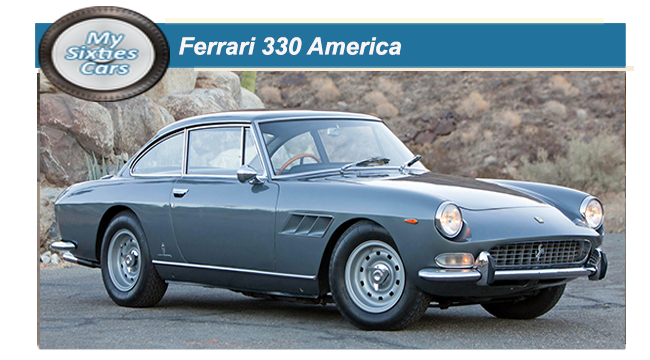
By 1964, Ferrari decided that the 250 GTE sales were not sufficient and the model was replaced by the Ferrari 330 America.
The new model evolved when Ferrari began to produce 250 GTE 2+2s equipped with the new Ferrari 330 engine by special order.
This new variation soon became dubbed the 330 America.
A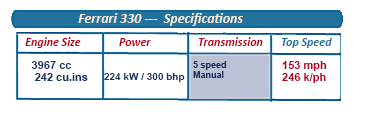 n all-new version, the 330 GT was formally released in January 1964 that featured an increase in interior space, thanks to its 5cm (2in) longer wheelbase.
n all-new version, the 330 GT was formally released in January 1964 that featured an increase in interior space, thanks to its 5cm (2in) longer wheelbase.
Safety was improved thanks to the addition of revamped disc brakes featuring separate front and rear systems.
To complete the picture Ferrari also revemped the 330GT's sstyling .
Not regarded as one of Pininfarina's best, the quad headlamp installation looked garish and clumsy, so 18 months later, those four headlights were replaced by one on either wing.
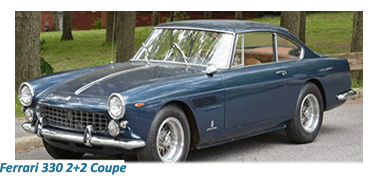 The arrival of the 330 signaled Ferrari's intention to be less pragmatic and reach out to buyers instead or continuing with their policy of “take it or leave it” that did not appear to be working.
The arrival of the 330 signaled Ferrari's intention to be less pragmatic and reach out to buyers instead or continuing with their policy of “take it or leave it” that did not appear to be working.
Beneath the hood of the 330GT was a 3967-cc V-12 engine producing 300 horsepower, while a five-speed manual gearbox was standard by 1965, but models used a four-speed with overdrive.
Separate braking systems were installed for front and rear. Alloy wheels became standard in 1965, with center-lock Borrani wires optional at extra cost (instead of standard as in early models).
![]()
To keep customer interest fresh, in addition to restyling the front end. Ferrari also added power steering and air conditioning to the options list, while there was much rumor before the launch that automatic transmission as an option was being considered. In the end, Ferrari decided against what would have been too radical a step for the company who had built their reputation on producing tough no-compromise track racers.
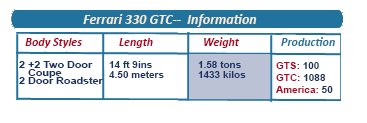 About a thousand 330 were produced over the full model run through 1968, as well as around 50 Type 330 GTE Americas, produced entirely during 1963.
About a thousand 330 were produced over the full model run through 1968, as well as around 50 Type 330 GTE Americas, produced entirely during 1963.
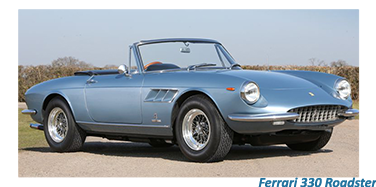 Except for a larger engine, the new 330 coupes and convertible were almost identical to the 275 series.
As styled by Pininfarina, the new coupe body was somewhat subdued, less rakish than other Ferraris, mixing the 275 GTS tail with a front end related to that of the 400 Superamerica.
In essence, the 330 coupe was a blend of 275 GTB chassis and 330 GT 2+2 engine. A small oval horizontal grille stood at the end of a pointed, tapered snout. with twin bumperettes alongside the grille.
Exposed headlamps sat above small lower nacelles while horizontal ribs went on sail panels, and vent wings were installed.
Three air-intake slots sat on the rear of front fenders, behind the tops of front wheels.
Except for a larger engine, the new 330 coupes and convertible were almost identical to the 275 series.
As styled by Pininfarina, the new coupe body was somewhat subdued, less rakish than other Ferraris, mixing the 275 GTS tail with a front end related to that of the 400 Superamerica.
In essence, the 330 coupe was a blend of 275 GTB chassis and 330 GT 2+2 engine. A small oval horizontal grille stood at the end of a pointed, tapered snout. with twin bumperettes alongside the grille.
Exposed headlamps sat above small lower nacelles while horizontal ribs went on sail panels, and vent wings were installed.
Three air-intake slots sat on the rear of front fenders, behind the tops of front wheels.
![]()

The identifying model script was evident on the rear deck, while a Ferrari insignia was prominently placed d ahead of the hood.
Debuting at the Geneva show in March 1966. the 330 GTC (Gran Turismo Coupe) had a front-mounted 3967-cc V-12 engine rated 300 horsepower at 7000 rpm and a five-speed rear transaxle, plus all-independent suspension and all-disc brakes1967 Ferrari 330 GTC.
By the mid-Sixties, the unique custom-built Ferraris were becoming few and far between the company gradually directing their policy towards more “ main stream” models that could appeal to a wider market and potential buyers with a more modest budget.




